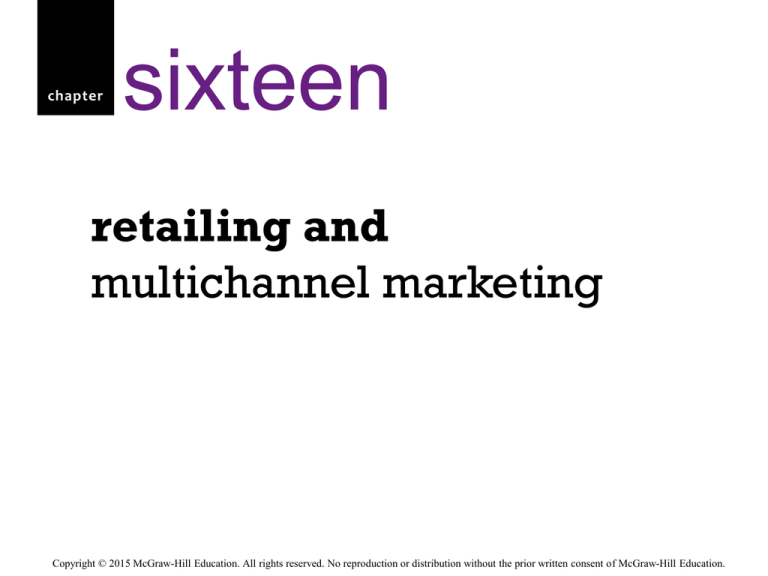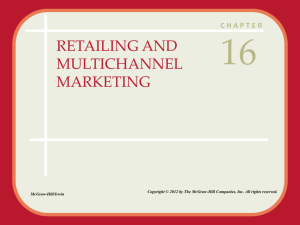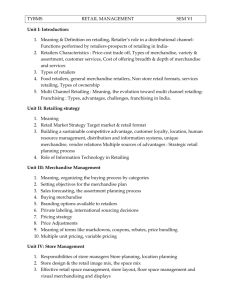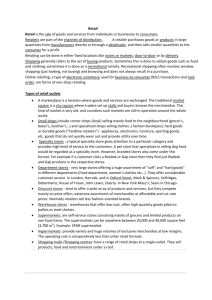
chapter
sixteen
retailing and
multichannel marketing
Copyright © 2015 McGraw-Hill Education. All rights reserved. No reproduction or distribution without the prior written consent of McGraw-Hill Education.
LEARNING OBJECTIVES
LO 16-1 Discuss the four factors manufacturers should
consider as they develop their strategy for working
with retailers.
LO 16-2 Outline the considerations associated with choosing
retail partners.
LO 16-3 List the three levels of distribution intensity.
LO 16-4 Describe the various types of retailers.
LO 16-5 Describe the components of a retail strategy.
LO 16-6 Identify the benefits of stores.
LO 16-7 Identify the benefits of multichannel retailing.
LO 16-8 Detail the challenges of multichannel retailing
16-2
Factors for Establishing
a Relationship with Retailers
Choosing
retailing
partners
Identifying
types of
Retailers
Developing
a retail
strategy
Managing a
multichannel
strategy
16-3
Choosing Retail Partners
Channel Structure
Degree of vertical
integration
Manufacturers brand
Power of
manufacturer and
retailer
©M Hruby
16-4
Choosing Retail Partners
Customer Expectations
16-5
Choosing Retail Partners
Channel Member Characteristics
Larger firms
Less likely to use
supply chain
intermediaries
Can gain more
control, be more
efficient, and
save money.
16-6
Choosing Retail Partners
Intensive
©Jeff Greenberg/PhotoEdit
Distribution Intensity
Selective
©Susan Van Etten/PhotoEdit
Exclusive
16-7
check yourself
1. What issues should manufacturers consider
when choosing retail partners?
2. What is the difference between intensive,
exclusive, and selective levels of distribution
intensity?
16-8
Types of Retailers
16-9
Food Retailers
Supermarket
Supercenter
Warehouse
Club
Convenience
Store
Limited nonfood
Includes discount
store
Limited
assortment
Differentiates
different types of
foods
Wal-Mart, Meijer,
K-Mart, Target
Little service
Includes:
Good locations
Costco, Sams, BJ’s
Limited variety
Peapod Website
16-10
General Merchandise Retailers
Department Stores
Full-line Discount
Specialty
Drugstores
Category Specialist
Extreme value
Off-Price
•Broad variety and deep assortment
•Broad variety at low prices
•Limited merchandise with service in small store
•Specialty for pharmaceutical and heath
•Discount with narrow but deep assortment
•Full line, limited, very low prices
•Inconsistent assortment of brand name at low prices
16-11
GNC Private Brands
Courtesy GNC Corporation
Courtesy GNC Corporation
16-12
Services Retailers
Firms that primarily sell
services rather than
merchandise, are a large
and growing part of the
retail industry
Ryan McVay/Getty Images
16-13
check yourself
1. What strategies distinguish the different
types of food retailers?
2. What strategies distinguish the different
types of general merchandise retailers?
3. Are organizations that provide services to
consumers considered to be retailers?
16-14
Developing a Retail Strategy
Using the Four P’s: Product
AP Photo/David Kohl
Providing the right mix of merchandise and services
16-15
Price
Price defines the
value of both the
merchandise and
the service
provided
Courtesy DDB - London
Walmart’s Profits Drop
16-16
Courtesy Bass Pro Shops
AP Photo/MarkHumphrey
Promotion
Retailers use a wide variety
of promotions, both within
their retail environment and
through mass media
16-17
Place
©M Hruby
Convenience is a key
ingredient to success
The McGraw-Hill Companies, Inc/
Jill Braaten, photographer
16-18
Benefits of Stores for Consumers
Browsing
Touching and Feeling
Personal Service
Cash and Credit
Entertainment and Social Interaction
Instant Gratification
Risk Reduction
16-19
Benefits of the Internet and
Multichannel Retailing
Deeper and Broader Selection
Personalization
Gain Insights into Consumer Shopping Behavior
Increase Customer Satisfaction and Loyalty
Expand Market Presence
16-20
Effective Multichannel Marketing
Integrated
CRM
Brand
Image
Pricing
Supply
Chain
16-21
check yourself
1. What are the components of a retail
strategy?
2. What are the advantages of traditional
stores versus Internet-only stores?
3. What challenges do retailers face when
marketing their products through multiple
channels?
16-22








